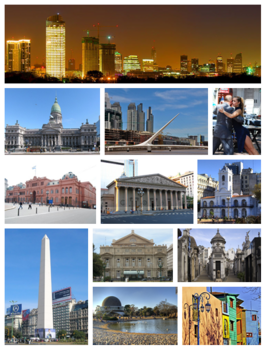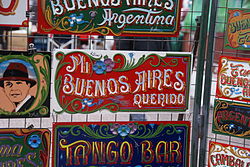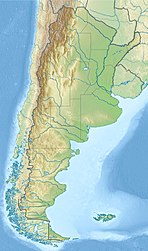Ciudad Autonoma de Buenos Aires
| Autonomous City of Buenos Aires | |||
|---|---|---|---|
| Ciudad Autónoma de Buenos Aires | |||

From top, left to right: panoramic view of the central business district, the Palace of the Argentine National Congress, Puente de la Mujer in Puerto Madero, tango dancers in San Telmo, Casa Rosada, the Metropolitan Cathedral, the Cabildo, the Obelisco, the Teatro Colón, La Recoleta Cemetery, the Planetario within the Palermo Woods, and Caminito in La Boca.
|
|||
|
|||
| Nickname(s): The Queen of El Plata (La reina del Plata), BA, Baires | |||
| Location in Argentina | |||
| Coordinates: 34°36′12″S 58°22′54″W / 34.60333°S 58.38167°WCoordinates: 34°36′12″S 58°22′54″W / 34.60333°S 58.38167°W | |||
| Country |
|
||
| Established | 2 February 1536 (by Pedro de Mendoza) 11 June 1580 (by Juan de Garay) |
||
| Government | |||
| • Type | Autonomous city | ||
| • Body | City Legislature | ||
| • Chief of Government | Horacio Rodríguez Larreta | ||
| • Senators | Federico Pinedo, Marta Varela, Pino Solanas | ||
| Area | |||
| • City | 203 km2 (78 sq mi) | ||
| • Land | 203 km2 (78.5 sq mi) | ||
| • Metro | 4,758 km2 (1,837 sq mi) | ||
| Elevation | 25 m (82 ft) | ||
| Population (2010 census) | |||
| • City | 3,890,151 | ||
| • Rank | 1st | ||
| • Density | 19,000/km2 (50,000/sq mi) | ||
| • Metro | 15,741,364 | ||
| Demonym(s) | porteño (m), porteña (f) | ||
| Time zone | ART (UTC−3) | ||
| Area code(s) | 011 | ||
| HDI (2011) | 0.889 Very High | ||
| Website |
www |
||

Fileteado
|
|
| UNESCO World Heritage Site | |
|---|---|
| Location |
Argentina, Argentina |
| Coordinates | 34°35′59″S 58°22′55″W / 34.5997°S 58.3819°W |
| Area | 203.3 km2 (2.188×109 sq ft) |
| Criteria | iv |
| Reference | 500 |
| Inscription | 2015 (39th Session) |
| Website | www |
|
[]
|
|
Buenos Aires (/ˌbweɪnəs ˈɛəriːz/ or /-ˈaɪrɪs/;Spanish pronunciation: [ˈbwenos ˈai̯ɾes]) is the capital and most populous city of Argentina. The city is located on the western shore of the estuary of the Río de la Plata, on the South American continent's southeastern coast. "Buenos aires" can be translated as "fair winds" or "good airs", but the first one was the meaning intended by the founders in the 16th century, by the use of the original name "Real de Nuestra Señora Santa María del Buen Ayre". The Greater Buenos Aires conurbation, which also includes several Buenos Aires Province districts, constitutes the fourth-most populous metropolitan area in the Americas, with a population of around 17 million.
The city of Buenos Aires is neither part of Buenos Aires Province nor the Province's capital; rather, it is an autonomous district. In 1880, after decades of political infighting, Buenos Aires was federalized and removed from Buenos Aires Province. The city limits were enlarged to include the towns of Belgrano and Flores; both are now neighborhoods of the city. The 1994 constitutional amendment granted the city autonomy, hence its formal name: Ciudad Autónoma de Buenos Aires (Autonomous City of Buenos Aires). Its citizens first elected a chief of government (i.e. mayor) in 1996; previously, the mayor was directly appointed by the President of the Republic.
...
Wikipedia




